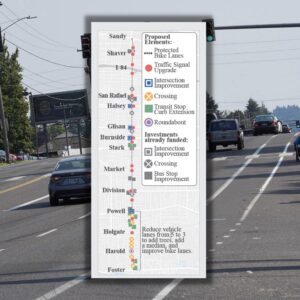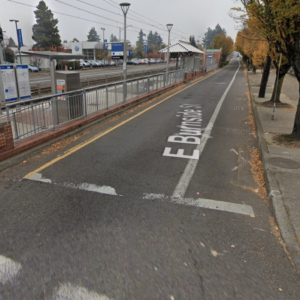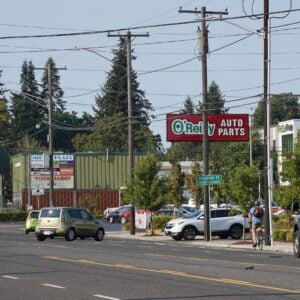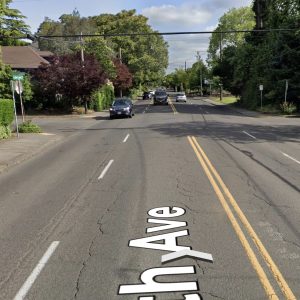One of Portland’s most prolific killers has struck again. Portland Police say Tuesday night just before 10:00 pm, a person was found dead on Northeast 122nd Avenue just north of Glisan. They believe the victim was walking prior to being hit and killed by someone driving a car.
Last night’s fatality was the 14th in past five years (2019 – 2023) on this street alone. Eight of the victims were on foot. This section of 122nd is about 75-feet wide with seven lanes used by drivers and a 30 mph speed limit.
122nd Avenue has been the focus of many speeches and plans over the past decade; but it remains a ticking time bomb of traffic tragedy and we’re years away from completion of infrastructure changes.
10 years ago this week, then Portland Bureau of Transportation Commissioner Steve Novick elevated the importance of making changes to 122nd Avenue when he lobbied for a “street fee” that would have allocated $20 million for better bus service on the street. That street fee would never come to pass, but it didn’t stop PBOT from working with TriMet to set aside $8 million for updates aimed at improving safety and adding a frequent service bus line.
At a press conference along 122nd Avenue in 2018, Novick’s successor Chloe Eudaly gave him credit as they both cut the ribbon on $4.7 million in crossing and transit-related improvements. But as I reported at that time, those relatively minor changes would not be enough to end the deaths and injuries caused by dangerous driving.

On a more positive note, PBOT has continued their effort to make 122nd a “civic corridor” — instead of the wide, fast, inhumane, deadly place it is now.
In 2022, PBOT won a $4.5 million federal Regional Flexible Fund Allocation grant (via Metro) that will help them add more lighting and build four new crossings on 122nd between NE Wasco and Beech. That project is due for construction in 2025 with completion the following year.
And earlier this year, PBOT won a $20 million grant through the Bipartisan Infrastructure Law that will help them build out $25 million worth of safety projects envisioned in the city’s 122nd Avenue Plan.
That plan is a roadmap to a safer 122nd between NE Sandy and SE Foster. Notably, of all feedback received by PBOT during the outreach for the 122nd Ave Plan, “community members expressed the most concerns about the stretch between NE Glisan Street and SE Powell Boulevard,” near where the person was found dead in the street last night. The Glisan intersection (which is designated a “high crash intersection” by PBOT) was ranked as a “near-term priority” and it was ranked third on a list of nine intersections that should be prioritized for improvement.
Nearly $30 million in safety changes is good news, but we won’t see the results for at least 3-4 years. That means 10-15 more people are likely to be killed while we wait.
It’s a sad truth that we know where traffic dangers lurk and we know how to mitigate them; but the pace of bureaucracy has so far failed to keep up with the speed of many drivers and the incessant traffic violence left in their wake.
Is our only option to sit back and wait for more victims? I hope we are better than that.







Thanks for reading.
BikePortland has served this community with independent community journalism since 2005. We rely on subscriptions from readers like you to survive. Your financial support is vital in keeping this valuable resource alive and well.
Please subscribe today to strengthen and expand our work.
There’s also a whole slew of additional victims within a few blocks of 122nd as drivers speed around the corners, on Glisan, Division, and even some minor streets. One of Portland’s leading serial killers even before the sidewalk infill.
The irony of course, is that 122nd meets every textbook definition of a “complete street” – it has wide sidewalks on both sides, parking lanes (often empty), painted bike lanes, two traffic lanes in each direction, and a center turn lane. It also has too many driveways, many major car dealerships, a public library, a fire station, Parkrose High School, numerous strip shopping centers and affordable-by-accident apartment complexes, one of Trimet’s busiest bus routes, a major arterial stroad with heavy traffic in the most auto-dependent parts of town. It’s the dividing line between many neighborhoods when it really needs to be the main street connecting them.
Unfortunately, it’s not particularly unique, in fact very common, both nationally and in East Portland: outer Division, Stark, Halsey, Airport, 82nd, and parts of Foster and ODOT’s Sandy are the same design and also are successful serial killers; PBOT has been able to partially tame Holgate, 102nd, 148th and 162nd, while ODOT’s outer Powell is being rebuilt as a “main street”.
Sadness. It’s crazy out there. No matter who you are and how you’re getting around town, please stay hyper vigilant, especially when driving. I walk, bike and drive, and everyday I see drivers, bikers and pedestrians doing stupid stuff, but drivers doing stupid stuff are the most dangerous, obviously. Just a few nights ago, in heavy rain, I saw moving vehicles without lights on, bikers without lights and reflectors riding out from a stop sign at 38th Ave across Belmont in front of my car without looking (luckily I had just enough time and space to stop before hitting them), and a man walking straight towards my car in my lane in the middle of the I-405 freeway on a darker area near the Vaughn St off-ramp. I spotted him with enough time to stop and turn on hazard lights but he walked past my car straight towards oncoming traffic. He wasn’t hit then but I wonder if he is who was hit five hours later on I-5. I called 911. I drive hyper aware but so many drivers do not. I saw a clueless driver on her phone sail through a red light in front of my car, if I’d pulled out without looking left when my light turned green I would have been t-boned and surely killed. Sadly, money is short and bureaucracy is large and people are imperfect and often stupid and people getting killed by moving vehicles will always occur, so please be vigilant. Always be alert and ready to run and jump away from danger on roads and sidewalks. And people who kill people with cars due to unsafe driving need to be put away for a long, long time.
Tragic but unfortunately unsurprising. As someone living very close to this collision and who often interacts with NE 122nd, this dangerous stroad is long overdue for a significant road diet. I really don’t think it can be made safe until those seven lanes are reduced to two or three. It would certainly make getting to my medical appointments much less stressful.
I live near there too.
And I agree, with all the jay walking going across 122nd to the bottle return location there definitely needs to be a Road Diet there (along with the rest of 122nd).
I’m curious why the sole responsibility lies on the road design, and not on the city to decrease the population of jaywalkers who live in parking spots and along sidewalks around this area
A road diet while needed, if not done in conjunction with a significant consistent effort to cleanup the area will likely actually result in continued exceptionally unsafe conditions as more areas to set up tents and park RVs will lead to an increase in unaware pedestrians.
This exact issue has played out along division, East of 148th. It has actually at times become more dangerous because you have unaware individuals who live in the public right of way stumbling into traffic, and ignoring the multitude of new crosswalks available to them. Instead darting across, between cars.
To the contrary, I think slowing down traffic and decreasing traffic volume can help lead to the neighborhoods surrounding 122nd (and plenty of other dangerous stroads) to becoming better places to be out and about. That is, places where it’s nice to walk around and shop, walk your dog, hang out at the park or plaza, have a nice stroll, etc. Higher volumes of people means more eyes on the environment means more help for those who need it and fewer bad actors feeling like they can get away with bad deeds. I think there’s a reason, for example, that you see most of the unsanctioned homeless camps in low foot traffic areas, places like along Lombard and Marine, in interstate right of way corridors, deep in Forest Park off of the trails, and along the floodplains of small rivers like Johnson Creek. If we want a safer 122nd Ave, not just from traffic violence but in all regards, we need to make it even more populous, not less.
Further, I really don’t think it’s quite fair to place the blame on “jaywalkers” and other pedestrians. The simple fact is that the act of walking, in and of itself, is not dangerous, while the act of operate a motor vehicle, particularly heavy ones and at high speeds, is. That’s why we license motorists, but you don’t need a license to walk out your front door and go for a stroll. The burden of understanding the safe operation of motorways rightly falls heavier on a motorist than it does on the more vulnerable and not necessarily more knowledgeable people around the motorist. Yes, the law technically states that we’re supposed to cross the road at crosswalks with some exceptions. Yes, many of us are socialized to be safe around streets–use a crosswalk, look both ways, make sure the driver can see you–but that does not mean that a failure to abide by those laws and social mores absolves the motorist of their failure to operate their heavy machinery in a safe manner, nor does it absolve transportation engineers and planners from failing to create a safe and effective transportation network.
If a motorist is driving within the law and somebody jaywalks in front of their vehicle in a manner that does not give the motorist enough time to stop or safely swerve to avoid hitting the person, and the person gets hit, that is the person’s fault, 100%. I say this as someone whose own mother just four months ago jaywalked, midblock, out from between two parked SUVs on a busy street without looking to her left and was immediately struck by a vehicle that was obeying the speed limit of 20 mph (probably even going slower than that, it was a Ford Expedition and my 76-year-old mother survived, albeit with many broken bones and is back to normal now). We do not blame the driver in the least. Sadly, my mother simply had a momentary lapse of attention and paid a serious price, but thankfully she’s alive and well now. Sometimes people make mistakes, including pedestrians, and it results in injury and death.
I agree with you, and that’s where it’s important to make sure the people and institutions who created that situation in the first place are also made to fix their bad situation. Infrastructure should be set up to account for human behavior, and human behavior sometimes includes mistakes and thoughtlessness. In root cause analysis we use the “hierarchy of controls” and what’s often informally called the “Swiss cheese model.” If there’s a rule that says, “Use a crosswalk, don’t enter the street between obstructions, and look left and right,” that’s an administrative control to the hazardous condition of fast automobiles conflicting with pedestrians. But you have to expect that some people won’t know that rule, or else may forget or choose not to follow it, which is why there are three other types of controls higher on the hierarchy: elimination, substitution, and engineering controls. An elimination of a hazard that might have saved your mother from injury might have been to eliminate visual obstructions between pedestrians and motorists, such as the removal of on-street parking. A substitution might be hard to really find, but perhaps additional or different crosswalks might have better encouraged your mother to utilize them. And an engineering control might be to calm traffic with various methods like speed bumps, narrower lanes, and visual clutter that would prompt the driver of the Ford Expedition to go at a slower speed, either minimizing the kinetic energy in the collision and reducing any injury, or perhaps helping to prevent the collision from occurring at all. Your mother unpredictably stepping out into traffic was her fault, sure, but the dangerous situation existing in the first place is wholly on the government entity(ies) having jurisdiction over that piece of public infrastructure that contributed to her injury.
This is safety engineering 101: you expect your perfect system to fail and try to design and plan for it to fail in a way that is as safe as possible. We just don’t do that in regards to traffic because we’re laser-focused on “level of service” and won’t do anything at all to reduce the vehicle throughput on roads, then turn around and often place the blame for death and injury on the same people who are often the most vulnerable on those roads.
I feel bad for those of you who have to interact with this stretch regularly. I only bike along it when I have to drop off/pick up fleet cars for my work from the ford shop out there. Use a folding bike to make that work and it is easily the only stretch in town that I feel unsafe at all times (and part of my normal commute involves east burnside in the 60/70’s stretch where it can be dicey at times).
An excellent and powerful first sentence Jonathan. Sad that it’s so accurate.
I realize it’s tacky to reply to oneself , but I can’t help wondering what the response would be from PPB if it actually was a serial killer on the loose rather than motorized traffic.
No. We don’t have to wait. We could try enforcing traffic laws.
This is not rocket science. Speed kills. No (or VERY little) traffic enforcement = traffic violence. Few if any consequences for lawbreakers: That’s the Portland problem in a nutshell.
Absolutely. The amount of high speeders and red light runners is still high compared to the times before the mayor told police not to enforce traffic laws because of COVID. (I’ve yet to hear him retract that policy)
Anyway, yes, enforcement is definitely needed, but can’t we do safety from all directions at the same time?
Enforcement
Separated Bike/Pedestrian Lanes (concrete/steel not plastic wands)
Bus Only Lanes
Road Diets
Etc.
From running a local community bike coop that also does recycling, we discovered that car and SUV drivers are as scared of cut spokes on pavement (which are mostly harmless to bicyclists) as bicyclists are to smashed glass on the street. We often leave the cut spokes on the ground partly from being lazy, but mostly to keep people from using our work area as a parking lot.
Our society is permissive of traffic violence. We know that the requirement to be licensed and insured is often unenforced and that’s a sad situation. However, the majority of people who are licensed and insured know that they rarely face legal censure for hurting people with a motor vehicle, and little cost beyond their deductible.
Police don’t ticket unless a driver is drunk or evades. Insurance companies are of course structured to make the smallest payout possible to victims who, if they live, may feel pain for years. Motor vehicle operation has the moral hazard that drivers don’t share the risk of people outside their vehicle, physically, financially or legally.
I say legally because a person who dies may have no witness and police often take a ‘windshield view’ of an incident. Nice people whose traffic experience is almost completely from the viewpoint of a motor vehicle operator are going to have difficulty empathizing with a person outside. The gatekeepers to our legal system spend much of their working life in cars.
Especially in Portland as we have decided that enforcement of our traffic laws should be “de-emphasized”. Now we’re paying the price for that.
When police are present, they don’t ticket clear violations. It’s a conscious policy. Twice a police officer has told me that their role, at most, was to see that vehicle operators exchange information and it’s an insurance matter. The most recent event was at an injury accident involving thousands of dollars in medical bills where a motor vehicle operator passed a stop sign and hit a cyclist in full daylight, dry pavement, and yes, wearing a helmet.
There’s no budget level or number of officers that will change that.
I was just there day before yesterday and filmed 5 people in 6 minutes jaywalking to get to the Bottle drop. I forwarded this to PBOT and asked them to put up a pedestrian barrier. It’s an accident waiting to happen.